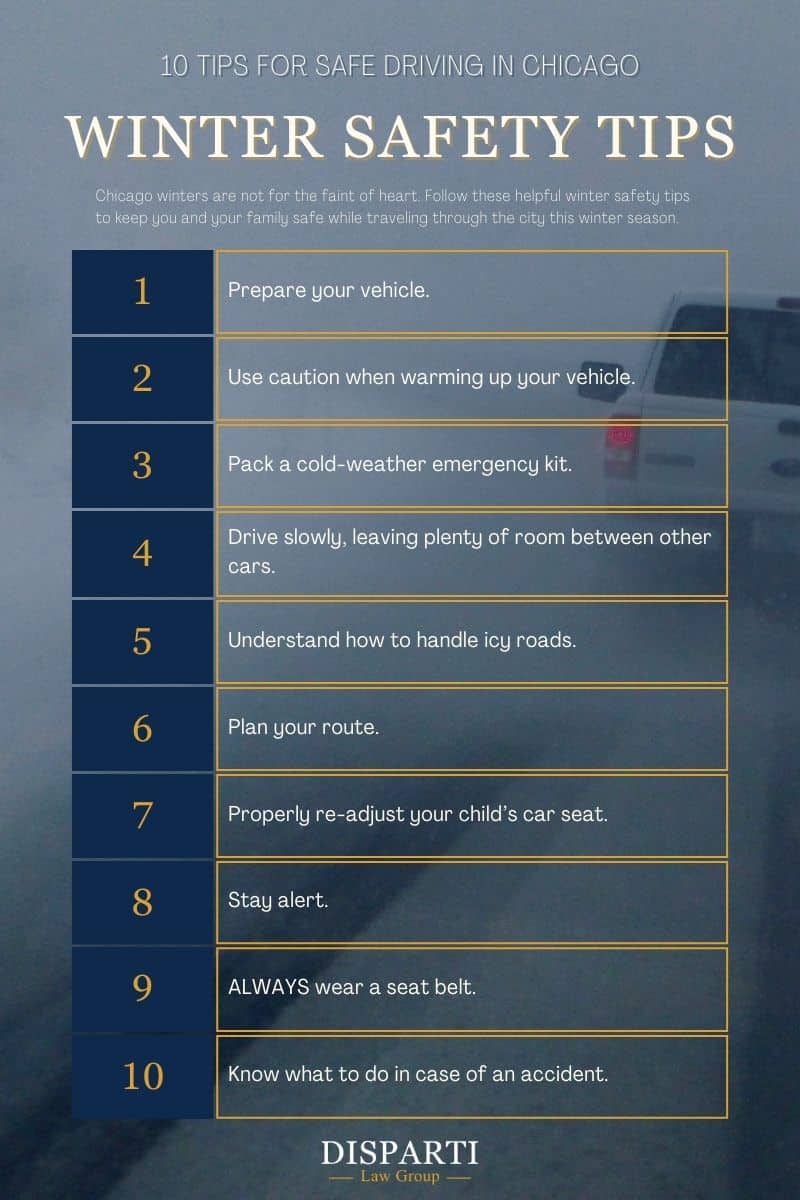Fall in Chicago is one of the most beautiful times of the year. The red and gold leaves paint the city and the crisp cool breeze brings a much-needed reprieve from the summer heat. While Fall is a great time to enjoy the apple orchards and pumpkin patches, it also serves as a valuable reminder — winter is coming.

10 Tips for Winter Driving
Colder temperatures introduce even more hazards Chicagoans must overcome while driving. As storms lurk, drivers should prepare for inclement weather. Don’t let the first snow sneak up on you. Before it’s too late follow these 10 tips for winter driving in Chicago, Illinois.
1. Prepare Your Vehicle
When driving in the winter, proper tire maintenance is critical.
Check your car battery: When the temperature drops, so does your battery’s power. Oftentimes, cars require more power as well. Make sure you have your battery checked out before the temperature is too frigid.
Replace old windshield wipers: Visibility during storms is critically important. Be sure to check your windshield wipers are in good working condition. Also consider replacing your wiper blades with winter blades, designed for snowy conditions.
Check your tires: Your tires must be properly inflated. When the temperatures dip, the pressure in your tires does as well. Make sure that you inflate them properly according to your vehicle manufacturer’s recommendations. You also want to make sure your tires are not worn. Driving on bald tires greatly increases the risk of hydroplaning on wet, snow-covered, or icy roads.
Keep gas tank half full: Visibility during storms is critically important. Be sure to check your windshield wipers are in good working condition. Also consider replacing your wiper blades with winter blades, designed for snowy conditions.
2. Use Caution When Warming Up Your Car
If possible, warm your car up before heading out. But only do this in well-ventilated areas. Never warm up a car in a garage or enclosed area to avoid risk of carbon monoxide poisoning. Also, never leave your car unattended while warming unless your vehicle offers a feature to securely start remotely.
3. Pack a Cold-Weather Emergency Kit
It’s always best to check the weather forecast before hitting the road to reduce the risk of getting caught in a storm. But sometimes, it’s impossible to avoid this. Having a cold-weather emergency kit in your car can quite literally save your life if you become stranded. Some items that may be worth packing in an emergency kit include:
- jumper cable
- extra coat
- portable phone charger
- flashlight
- blankets
- flashers
- window scraper
- any important medications (i.e. epi-pens or inhalers)
- shovel
- non-perishable food
Also, never leave the house without your cell phone. You want to be able to call for help.
4. Drive slowly, leaving plenty of room between other cars.
With an increased risk of skidding out of control, leave an extra bit of room between you and the car in front of you—about 5 to 6 seconds. Travel at slower speeds so you have time to respond to any hazards.
Give yourself plenty of time to stop and check your rearview mirrors in case the driver behind you cannot stop. It may be best to continue moving forward. At an intersection, look both ways before continuing forward on the green light or your turn at a stop sign. You never know if a car in the opposite direction is unable to stop and is forced to run a red light or stop sign.
5. Understand how to handle icy roads.
Do your best not to panic if you hit a patch of ice. And whatever you do, do not slam on the brakes as you may lose control of your vehicle. Most modern cars will have anti-lock braking systems (ABS) which means the best way to stop or slow down is to press down gradually on the brakes.
If you feel your car skidding out of control, avoid making any sudden maneuvers. You’ve probably heard it said to “steer into the skid.” All this means is if your back tires are skidding to the right, for example, steer to the right slightly until you regain control.
If you start skidding while accelerating, slightly let up on the gas. The same goes if you start skidding while hitting the brakes, slightly let up on the brake pedal.

6. Plan your route.
Gone are the days of printing out Mapquest directions before leaving the house. Now, many of us simply hop in our car, quickly pull up directions on our phones, and drive off in a scurry.
But when there is inclement weather, try to get in the habit of planning your route ahead of time. Take the time to consider streets that may be more difficult to pass or icy bridges that are best to avoid.
7. Properly re-adjust your child’s car seat.
Be sure to keep in mind that your child’s car seat will fit differently when they wear bulky winter clothing. Follow Illinois car seat laws to help you properly readjust the straps for the best (and safest) fit.
8. Stay alert.
Driving without distractions is a good idea any time of the year but it’s especially important in winter weather. Consider purchasing a phone holder for your car so you are not looking down to follow driving directions. It can also reduce the urge to scroll when you should be paying attention to potential hazards on the road.
Never let your guard down, and never underestimate how bad the roads may be. Black ice is extremely difficult to spot but drivers should look out for dull spots that appear slightly darker than the rest of the road.
9. ALWAYS wear a seat belt.
It’s the law. In Illinois, all drivers and passengers, no matter their age, are required to wear a seat belt at all times. There’s no question that accidents tend to increase in the winter. Seat belts are designed to save lives so be sure to buckle up on every single ride.
10. Know what to do in case of an accident.
Even when you do everything in your power to keep yourself and your family safe while driving in winter weather, the unfortunate truth is that some things are out of our control. Car accidents in the snow and ice happen.
Call 9-1-1 if you or anyone else suffered an injury or serious property damage, or if the accident is blocking the road. If no one is injured and damage to both vehicles is minimal, it may be best to move away from traffic to avoid causing another accident.
Whether the accident is minor or severe, always exchange contact and insurance information with the other party if you are physically able. Before parting ways, dial the number they give you to confirm it’s correct and legitimate. Also, try to take pictures before either vehicle is moved for insurance purposes.
Finally, keep the number of an experienced car accident lawyer handy. A lawyer can coach you through the legal process of filing an insurance claim or personal injury claim to recover damages and it’s usually best to have representation from start to finish to help maximize the compensation you deserve.
For a FREE case review with an accident attorney at Disparti Law Group Accident & Injury Lawyers, call (312) 600-6000 and find out why thousands say… Larry wins!









